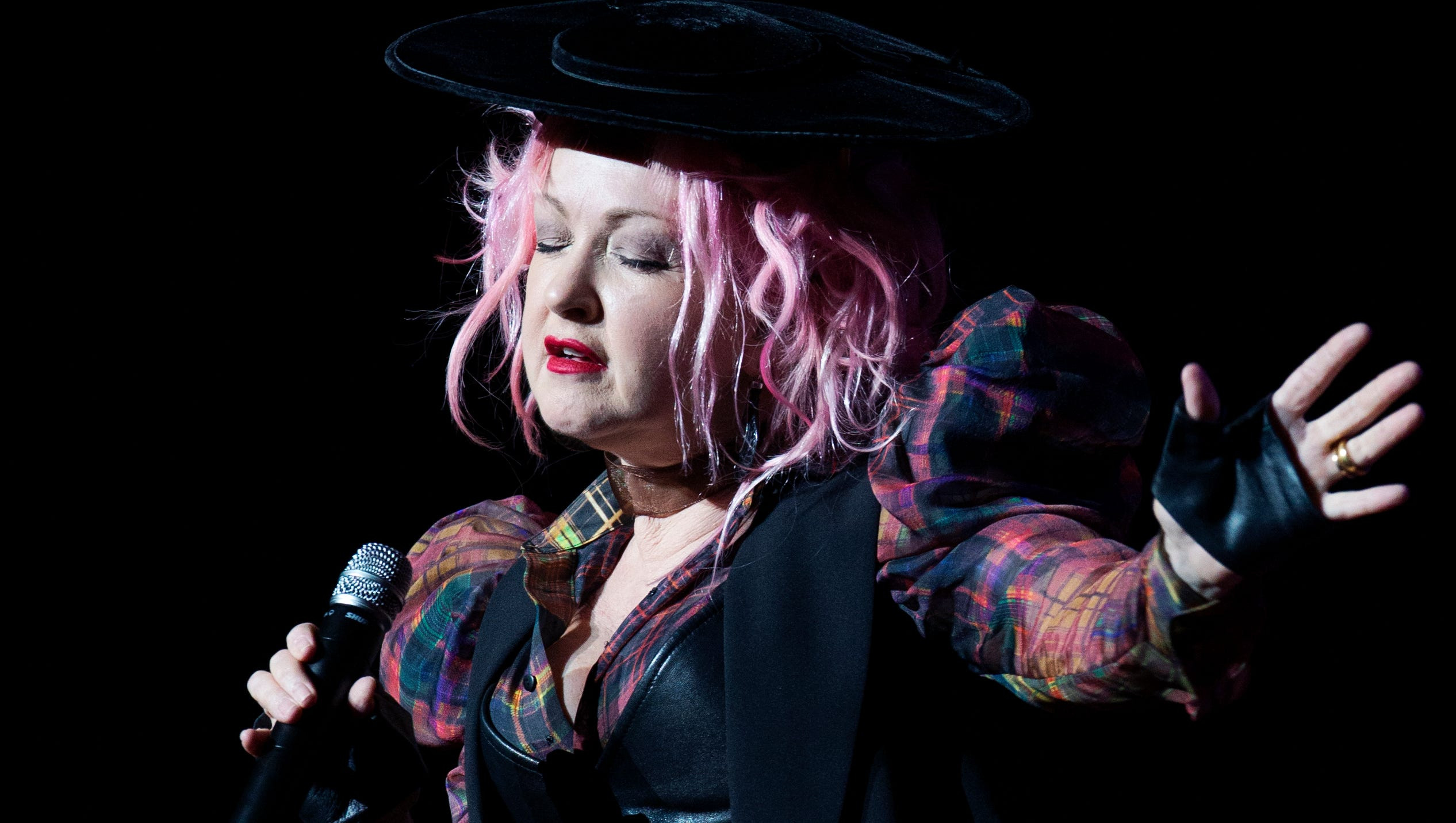Listening to “True Colors” on the radio, it’s easy to understand why many consider it an empowering anthem. The core message seems to be one of unwavering support and unconditional love, perfectly encapsulated in the famous lines:
But I see your true colors shining through
I see your true colors – that’s why I love you
So don’t be afraid to let them show
Your true colors are beautiful– like a rainbow.
 Cyndi Lauper True Colors performance
Cyndi Lauper True Colors performance
While the sweetness of these lyrics is undeniable, a closer look, especially at Cyndi Lauper’s rendition, reveals a more complex and nuanced interpretation of the “True Colors Song” than a simple feel-good message. The initial lines might paint a picture of pure adoration, but the word “but” at the beginning of the chorus hints at an underlying tension. It suggests a journey, a seeing through something to get to those “true colors.”
Beyond the Empowerment Anthem: Delving Deeper into True Colors Meaning
Many listeners connect with “True Colors” on a surface level, dreaming of being seen for their inner selves, beyond flaws and imperfections. Lauper’s vocal delivery of “rainbow” is particularly captivating, almost like a comforting sound, drawing listeners into this fantasy of ideal acceptance. In contrast to her typically heavily produced and playful vocal style, here, Lauper adopts a more vulnerable and thoughtful approach. This rawness, devoid of excessive studio enhancements, imbues her voice with a profound empathy.
When she sings the verses:
Oh , I realize it’s hard to take courage
In a world full of people
You can lose sight of it all
And the darkness inside you makes you feel so small
Her voice diminishes in volume and intensity, some words becoming almost inaudible. This vocal choice makes it feel as though Lauper is genuinely experiencing the very darkness she promises to see through in the chorus. This is a powerful lesson in the song’s perceived message of ideal love: to truly love someone is to empathize deeply with their pain, transcend it, and reveal the inherent beauty obscured by their struggles. It’s about embracing their “small darkness” as a mere facade concealing their vibrant, “true,” rainbow colors. This interpretation is undoubtedly why the song resonates so deeply with so many, and it’s virtually the sole interpretation offered by Phil Collins in his more saccharine cover version.
The Stark Reality Behind Lauper’s True Colors
However, Cyndi Lauper’s rendition of “True Colors” is intentionally starker and harsher than the seemingly comforting lyrics suggest, setting it apart from Collins’ version and revealing a more profound depth. Billy Steinberg, one of the original songwriters, noted in an interview how Lauper drastically departed from their demo, which was conceived in a “gospel ballad tradition” akin to songs like “Bridge Over Troubled Water,” “Let It Be,” or “Lean On Me.” These songs are musically and vocally more straightforward. Lauper, however, created something “breathtaking and stark.”
What makes Lauper’s version so adventurous? Beyond the Appalachian dulcimers, it’s her vocal choices that truly distinguish it from her other hits. The fragility in the “darkness” lines has already been noted. Lauper herself described her vocal approach as whispering and speaking through certain lines to connect with the most vulnerable part of the listener: “I realized it had to be a voice that whispers to you, a voice that’s almost childlike so it will speak to the softest, most gentle part of the human being. It’s a voice whispering to you, telling you it’s going to be ok.”
But here’s the crucial twist: the whispered lines aren’t simply assuring reassurance. The “adventurous, stark, breathtaking” element lies in the unexpected harshness that Lauper injects into lyrics that might seem to call for a gentle delivery. Her voice cracks with a palpable sense of pain and frustration on “True Colors” and becomes hoarse on “that’s why I love you.” This vocal delivery hints at the immense effort and emotional toll that this kind of “true colors” love demands. This begs the question: why this vocal approach, so different from the smoother, more comforting styles of “Bridge Over Troubled Water” or even Lauper’s own “Time after Time,” which expresses a similar sentiment of unconditional love without the same harshness?
The Frustration of Unconditional Love in True Colors
The answer lies in the uncomfortable possibility that things might not be okay. If we listen closely to the whispered lines, stripped of a purely gentle and sweet delivery, they take on a more brutal edge:
Show me a smile, then – don’t be unhappy
Can’t remember when I last saw you laughing
There’s a cruel irony embedded in these lines. The singer, the one who claims to see the other person’s inner beauty and rainbow qualities, is also the one urging them to “show a smile” and to laugh, even when they are clearly struggling. It reveals a subtle demand for positivity, even in the face of despair.
If this world makes you crazy
And you’ve taken all you can bear
Just call me up – because you know I’ll be there!
Again, the message seems supportive, but what kind of support is offered by someone who, while claiming to see your “true colors,” simultaneously pushes for outward displays of happiness when you’re feeling broken? It’s a dynamic many recognize: the well-intentioned but often ineffective “try to be more positive” approach to dealing with suffering, both in others and ourselves. Often, when we encourage someone to shift their perspective, we are, perhaps unconsciously, trying to overlay their “darker colors” with our own “brighter ones,” rather than truly seeing and accepting their “true” colors.
However, unlike everyday interactions, Lauper is singing, and her musicality allows her to transcend the limitations of spoken words. As one musically astute listener noted, there’s a “clash between the almost mechanical synths and Cyndi’s vocal dynamics,” yet “the musical background also grows and breathes,” expanding and contracting with the emotional ebb and flow of the song. This musical tension mirrors the emotional conflict at the heart of “True Colors.”
Ultimately, “True Colors” exists in this fascinating space between two opposing desires. The songwriters, Lauper as the singer-producer, and the audience all yearn for the ideal of unconditional love – loving someone despite, or even for, the depths of their sadness. Yet, the lyrics and Lauper’s distinctive vocal performance, almost against their will, reveal the inherent frustration that accompanies loving someone characterized as “dark,” “small,” “crazy,” “unlaughing,” and “unsmiling.” The declaration “That’s how I love you, despite what you act like,” to be truly honest, must be sung with a degree of pain.
This inherent tension is what elevates Cyndi Lauper’s “True Colors” far beyond a simple empowerment anthem. While a Phil Collins version might offer comfortable reassurance, Lauper’s rendition creates a lingering “itch,” a constant fascination with this brittle, grating form of unconditional love. It’s a far more compelling and honest portrayal than a song that merely promises everything will be alright. In its very imperfections and contradictions, Cyndi Lauper’s “True Colors” achieves a vocal transcendence that resonates long after the music fades.

